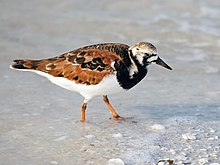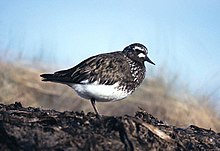Turnstone
| Turnstone | |
|---|---|

| |
| Ruddy turnstone in nonbreeding plumage | |

| |
| Black turnstone in winter plumage | |
| Scientific classification | |
| Domain: | Eukaryota |
| Kingdom: | Animalia |
| Phylum: | Chordata |
| Class: | Aves |
| Order: | Charadriiformes |
| Family: | Scolopacidae |
| Subfamily: | Arenarinae |
| Genus: | Arenaria Brisson, 1760 |
| Type species | |
| Tringa interpres Linnaeus, 1758
| |
| Species | |
|
| |
| Synonyms | |
| |
Turnstones are two
The genus Arenaria was introduced by the French zoologist Mathurin Jacques Brisson in 1760 with the ruddy turnstone (Arenaria interpres) as the type species.[2][3] The genus name arenaria is from Latin arenarius, "inhabiting sand", from arena, "sand".[4]
The genus contains two species: the ruddy turnstone (Arenaria interpres) and the black turnstone (Arenaria melanocephala).[5] Both birds are waders. Their length is typically between 20 and 25 cm, with a wingspan between 50 and 60 cm and a body mass between 110 and 130g. For waders their build is stocky, with short, slightly upturned, wedge shaped bills. They have white patches on the back, wings and tail. They are high Arctic breeders, and are migratory. Their strong necks and powerful, slightly upturned bills are adapted to their feeding technique. As the name implies, these species overturn stones, seaweed, and similar items in search of invertebrate prey.[6] They are strictly coastal, prefer stony beaches to sand, and often share beach space with other species of waders such as purple sandpipers.
Species

Ruddy turnstone
The
In breeding plumage, this is a showy bird, with a black-and-white head, chestnut back, white underparts and red legs. The drabber winter plumage is basically brown above and white below. This is a generally tame bird and is an opportunist feeder. Unlike most waders, it will scavenge, and has a phenomenal list of recorded food items, including human corpses and coconut. The call is a staccato tuck- tuck- tuck.
Black turnstone

The black turnstone (Arenaria melanocephala) has a similar structure to its widespread relative, but has black upperparts and chest, and white below. It has a much more restricted range than the ruddy turnstone, breeding in western Alaska, and wintering mainly on the Pacific coast of the United States.
There exists a
References
- ^ Brisson, Mathurin Jacques (1760). Ornithologie, ou, Méthode Contenant la Division des Oiseaux en Ordres, Sections, Genres, Especes & leurs Variétés (in French and Latin). Paris: Jean-Baptiste Bauche. Vol. 1, p. 48, Vol. 5, p. 132.
- ^ Peters, James Lee, ed. (1934). Check-list of Birds of the World. Vol. 2. Cambridge, Massachusetts: Harvard University Press. p. 271.
- ISBN 978-1-4081-2501-4.
- ^ Gill, Frank; Donsker, David, eds. (2019). "Buttonquail, plovers, seedsnipe, sandpipers". World Bird List Version 9.1. International Ornithologists' Union. Retrieved 2 April 2019.
- ISBN 978-0007268146
- JSTOR 1363487.
External links
- Ruddy turnstone = turnstone - Species text in The Atlas of Southern African Birds
- Ruddy turnstone – Cornell Lab of Ornithology
- Ruddy turnstone Arenaria interpres – USGS Patuxent Bird Identification InfoCenter
- Turnstones feeding and bathing
